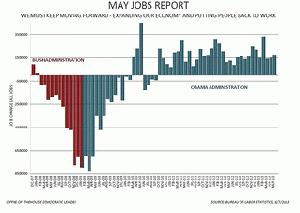May 2013 Jobs Report by Leader Nancy Pelosi
I know we live in a fact-free era when the public, politicians, and pundits don't care about them any longer. But this seems to go even further. From the Weekly Standard 7.6 Percent 8:31 AM, Jun 7, 2013 " By Daniel Halper.
"The unemployment rate ticked up, according to new numbers from the Bureau of Labor Statistics: Total nonfarm payroll employment increased by 175,000 in May, and the unemployment rate was essentially unchanged at 7.6 percent." C0nfused? Me too. The unemployment rate ticked up and remained essentially unchanged. Maybe now we can have our cake and eat it too.
But this piece is about more than our ability to tolerate the nonsense of politically oriented distortions. It brings together two factors that give a fuller explanation for the resistance of our economic anemia.
From the article cited above, "Among the major worker groups, the unemployment rates for adult men (7.2 percent), adult women (6.5 percent), teenagers (24.5 percent), whites (6.7 percent), blacks (13.5 percent), and Hispanics (9.1 percent) showed little or no change in May. The jobless rate for Asians was 4.3 percent (not seasonally adjusted), little changed from a year earlier."
The unemployment problem is not homogeneous, i.e., having the same kind of constituent elements. As anyone can readily see there are resistant pockets of unemployment within segments of our society.
We've seen a shift from low tech to high tech for the last four decades. Marketable skills require post secondary education. The jobs that could be done with low tech skills are mostly gone and aren't coming back.
Either we fix the problems in these resistant pockets of unemployment or we settle for a society with a caste system.
Still doubt that idea? Read on, From ThinkProgress.org, First Quarter Of 2013 Saw Largest Wage Drop Ever By Alan Pyke on Jun 7, 2013, "The first three months of 2013 saw wages fall 3.8 percent -- the largest drop in hourly pay in the 65-year history of that statistic -- despite an increase in worker productivity. With high unemployment freeing employers from fears that their employees will turn elsewhere, the U.S. recovery has been marked by a decoupling of rising productivity from stagnant wages.
The gloomy milestone partly reflects the predominance of low-wage service jobs in the slow, steady streak of job growth since the recession."
A wonderful example is found in on ThinkProgress.org, in an article titled, Walmart's Low Wages Cost Taxpayers Millions Each Year, by Bryce Covert posted from ThinkProgress Economy on Jun 7, 2013.
"Due to low wages and few benefits, Walmart workers at a single 300-person Supercenter store rely on anywhere from $904,542 to $1,744,590 in public benefits per year, costing taxpayers, according to a new report from the Democratic staff of the House Committee on Education and the Workforce.
The report focused its analysis on Wisconsin, because the state's data is the most comprehensive and up to date. It looked at how many workers enroll in the state's Medicaid program and extrapolated how many services they rely on from programs such as the Supplemental Nutrition Assistance Program, Earned Income Tax Credit, school lunch program, Low Income Home Energy Assistance Program, and Section 8 housing vouchers, among others.
Walmart's wages are some of the lowest in the industry ["] Workers make $8.81 per hour on average, 28 percent less than those who work for other large retailers.
Rival Costco, which competes with Walmart's Sam's Club stores, pays employees about 40 percent more. The average Costco worker makes $21.96 an hour. Nearly all of the workers who are eligible for the company's benefits are enrolled.
Costco profits rose by 19 percent to $459 million last quarter.
(Note: You can view every article as one long page if you sign up as an Advocate Member, or higher).






